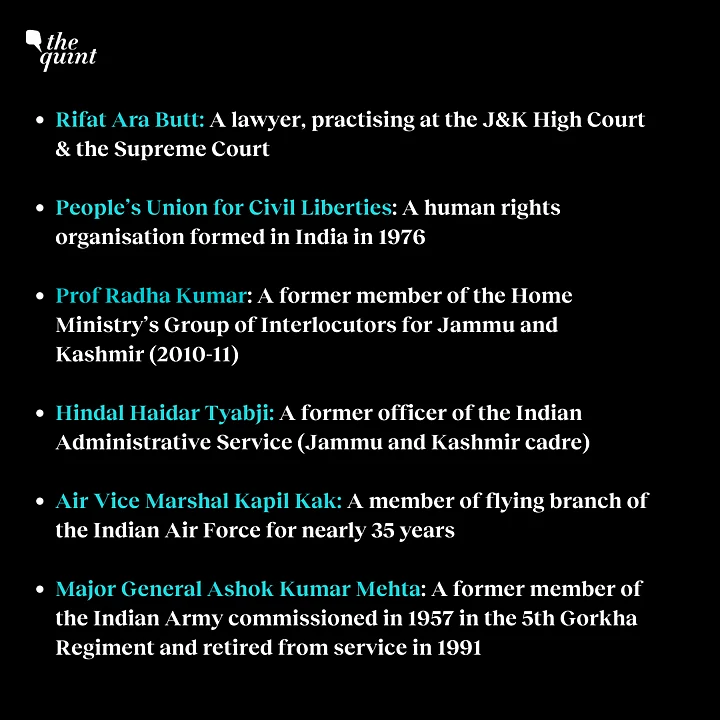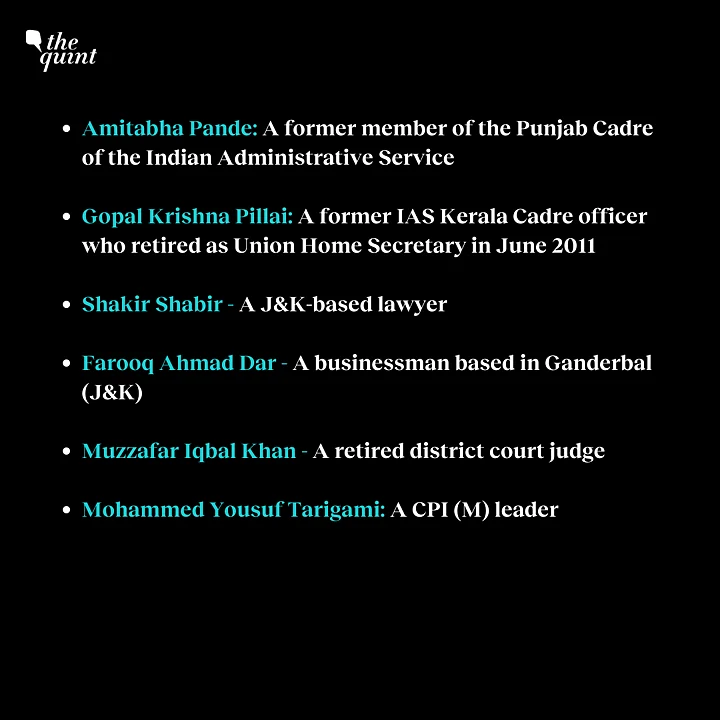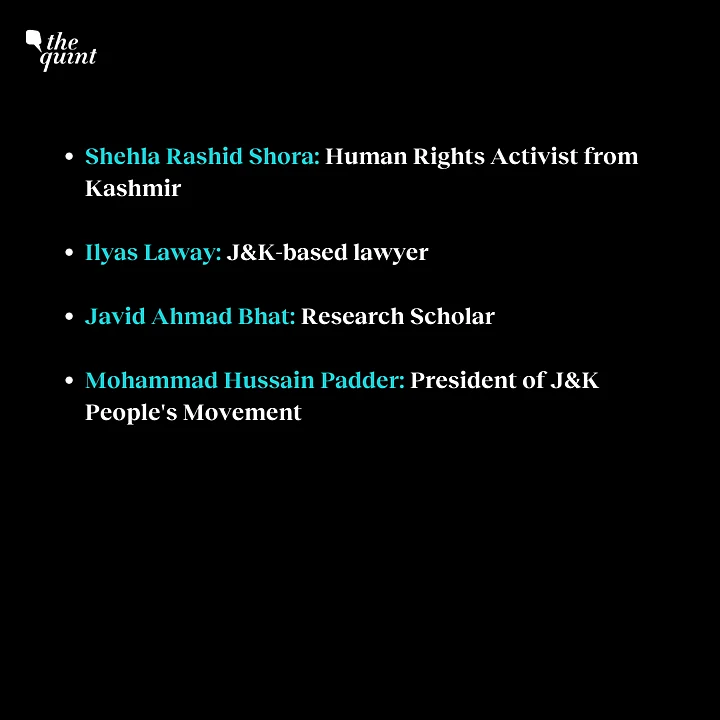A professor. A retired member of the Air Forces. A former IAS officer. A businessman. An artist.
These are only a few of the 22 people who have challenged the Union government’s 2019 decision to abrogate Article 370 – which granted special status to Jammu and Kashmir (J&K) – at the Supreme Court of India. Their grounds for challenge are that the move was “unconstitutional” and “arbitrary”.
Nearly four years after the government revoked the special status of J&K which led to the bifurcation of the state in 2019, India’s apex court is scheduled to deliver its verdict on Monday, 11 December.
The apex court held hearings in the high-profile case for a marathon 16 days and reserved its judgment on 5 September.
A five-judge Constitution Bench – comprising CJI DY Chandrachud & Justices SK Kaul, Sanjiv Khanna, BR Gavai & Surya Kant – on 11 July issued procedural directions about how and when to proceed with the case.
So, what exactly did these petitions revolve around? Who else challenged this in the top court? The Quint answers.
Artist, Ex-Judge & Others: Meet Those Challenging Article 370 Abrogation in SC
1. Who Are The Original Petitioners?
Even though there have been some developments since the petitions were first filed in the apex court, with some petitioners even opting out of the legal battle, here are the original petitioners in the case:
Expand2. Where Does Their Case Stand?
"I have withdrawn the petition in the Supreme Court challenging the Presidential Order to scrap Article 370 long ago," IAS officer Shah Faesal told news agency ANI last week.
He further went on to tweet about the decision:
"370, for many Kashmiris like me, is a thing of the past. Jhelum and Ganga have merged in the great Indian Ocean for good. There is no going back. There is only marching forward."
Faesal had offered his resignation from the civil services in January 2019 and floated the Jammu and Kashmir People's Movement (JKPM) party in March that year. He had stepped down from his post, reportedly in protest against the “unabated killings in Kashmir and absence of any credible political initiative from the Union government.”
Immediately after the abrogation of article 370, however, he was detained for over a year under the stringent Public Safety Act.
Then following his release in 2020, he continued to remain under house arrest. Soon after his release from an MLA hostel in Srinagar, he dropped all references to the JKPM party from his Twitter handle and deleted all old posts from his timeline.
Faesal was reinstated by the Union Government in April 2022. He is currently the Deputy Secretary in the Union Ministry of Culture.
While Faesal has decided to delete his name from the petition, along with activist Shehla Rashid Shora, the rest haven’t so far.
The remaining petitions continue to challenge:
- The dilution of Article 370, questioning the validity of the presidential orders dated 5 and 6 August which allowed this
- The bifurcation of the state into two union territories, including the J&K Reorganisation Act 2019 which allowed this
Expand3. Some Background
In 2020, then Chief Justice Ranjan Gogoi referred the petitions challenging the constitutional validity of the abrogation of Article 370 Constitution Bench consisting of five judges, headed by Justice NV Ramana.
The bench also included Justices SK Kaul, R Subhash Reddy, BR Gavai, and Surya Kant.
An initial question arose as to whether a reference to a seven-judge bench was necessary due to apparent differences in the opinions expressed by two of the Supreme Court benches in two cases (Prem Nath Kaul v State of Jammu & Kashmir, 1959 and Sampat Prakash v State of Jammu & Kashmir, 1970).
These decisions, rendered by separate five-judge benches, seemed to conflict in their interpretation of Article 370: In the Sampat Prakash case, the apex court upheld a Presidential Order passed under Article 370 subsequent to 1957 and in the Prem Nath Kaul case, the court had held that the President and Parliament no longer enjoyed those powers under Article 370.
However, the top court in 2020 concluded that there was no actual conflict between the two judgments and consequently declined the request for a larger bench reference.
The court reasoned that the two decisions should not be interpreted in isolation from their specific facts and context. It emphasised that the cases involved different circumstances and issues, cautioning against selectively extracting observations to assign them a specific meaning.
The court, however, clarified that its ruling was limited to the preliminary issue of whether a larger bench reference was necessary and that it had not addressed any substantive matters in the dispute.
Expand4. So, What Next?
In its order, the top court is expected to answer the following:
Could Article 370(1)(d) [which paved the way for applying the entire Indian Constitution to J&K] be validly used to alter the interpretation of Article 370, as was done via a Presidential order?
Do the Rajya Sabha's statutory resolution and the President's orders violate the fundamental democratic rights of the people of J&K under Articles 14 and 21 of the Constitution, by abrogating Article 370 without their consent during President’s Rule?
Does the Jammu and Kashmir (Reorganisation) Act, 2019 (which bifurcated the state into two UTs) violate Article 3 and Part III of the Constitution?
(This explainer was originally published on 12 July 2023. It has been republished from The Quint's archives ahead of the verdict.)
Expand
Who Are The Original Petitioners?
Even though there have been some developments since the petitions were first filed in the apex court, with some petitioners even opting out of the legal battle, here are the original petitioners in the case:
Where Does Their Case Stand?
"I have withdrawn the petition in the Supreme Court challenging the Presidential Order to scrap Article 370 long ago," IAS officer Shah Faesal told news agency ANI last week.
He further went on to tweet about the decision:
"370, for many Kashmiris like me, is a thing of the past. Jhelum and Ganga have merged in the great Indian Ocean for good. There is no going back. There is only marching forward."
Faesal had offered his resignation from the civil services in January 2019 and floated the Jammu and Kashmir People's Movement (JKPM) party in March that year. He had stepped down from his post, reportedly in protest against the “unabated killings in Kashmir and absence of any credible political initiative from the Union government.”
Immediately after the abrogation of article 370, however, he was detained for over a year under the stringent Public Safety Act.
Then following his release in 2020, he continued to remain under house arrest. Soon after his release from an MLA hostel in Srinagar, he dropped all references to the JKPM party from his Twitter handle and deleted all old posts from his timeline.
Faesal was reinstated by the Union Government in April 2022. He is currently the Deputy Secretary in the Union Ministry of Culture.
While Faesal has decided to delete his name from the petition, along with activist Shehla Rashid Shora, the rest haven’t so far.
The remaining petitions continue to challenge:
- The dilution of Article 370, questioning the validity of the presidential orders dated 5 and 6 August which allowed this
- The bifurcation of the state into two union territories, including the J&K Reorganisation Act 2019 which allowed this
Some Background
In 2020, then Chief Justice Ranjan Gogoi referred the petitions challenging the constitutional validity of the abrogation of Article 370 Constitution Bench consisting of five judges, headed by Justice NV Ramana.
The bench also included Justices SK Kaul, R Subhash Reddy, BR Gavai, and Surya Kant.
An initial question arose as to whether a reference to a seven-judge bench was necessary due to apparent differences in the opinions expressed by two of the Supreme Court benches in two cases (Prem Nath Kaul v State of Jammu & Kashmir, 1959 and Sampat Prakash v State of Jammu & Kashmir, 1970).
These decisions, rendered by separate five-judge benches, seemed to conflict in their interpretation of Article 370: In the Sampat Prakash case, the apex court upheld a Presidential Order passed under Article 370 subsequent to 1957 and in the Prem Nath Kaul case, the court had held that the President and Parliament no longer enjoyed those powers under Article 370.
However, the top court in 2020 concluded that there was no actual conflict between the two judgments and consequently declined the request for a larger bench reference.
The court reasoned that the two decisions should not be interpreted in isolation from their specific facts and context. It emphasised that the cases involved different circumstances and issues, cautioning against selectively extracting observations to assign them a specific meaning.
The court, however, clarified that its ruling was limited to the preliminary issue of whether a larger bench reference was necessary and that it had not addressed any substantive matters in the dispute.
So, What Next?
In its order, the top court is expected to answer the following:
Could Article 370(1)(d) [which paved the way for applying the entire Indian Constitution to J&K] be validly used to alter the interpretation of Article 370, as was done via a Presidential order?
Do the Rajya Sabha's statutory resolution and the President's orders violate the fundamental democratic rights of the people of J&K under Articles 14 and 21 of the Constitution, by abrogating Article 370 without their consent during President’s Rule?
Does the Jammu and Kashmir (Reorganisation) Act, 2019 (which bifurcated the state into two UTs) violate Article 3 and Part III of the Constitution?
(This explainer was originally published on 12 July 2023. It has been republished from The Quint's archives ahead of the verdict.)




